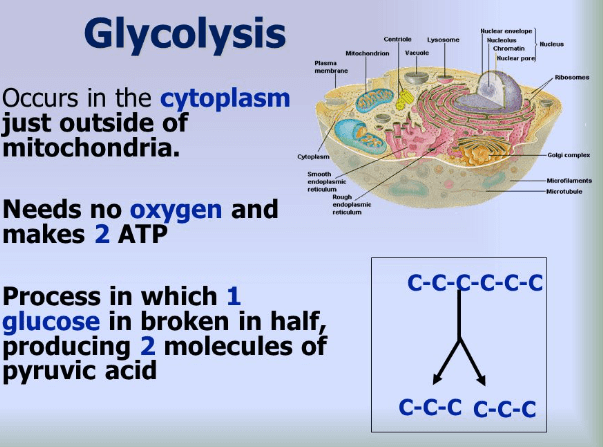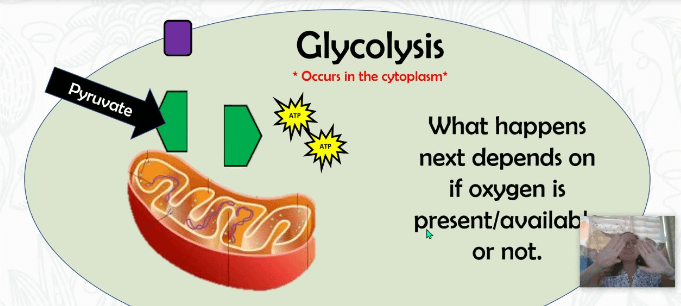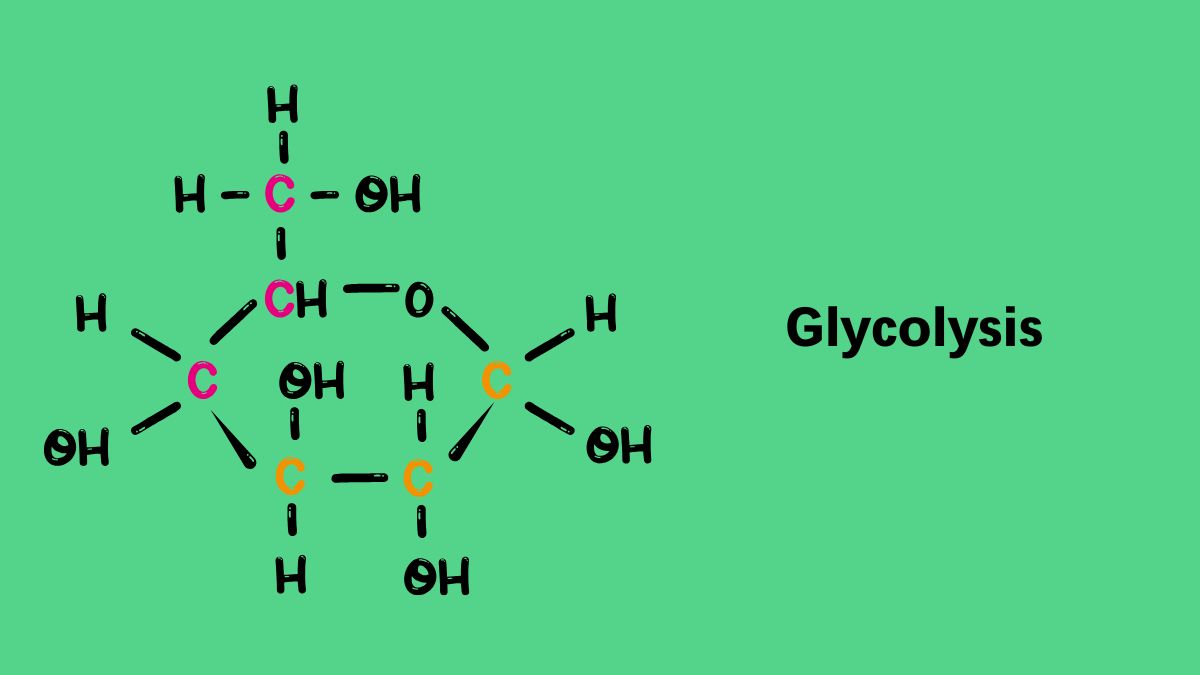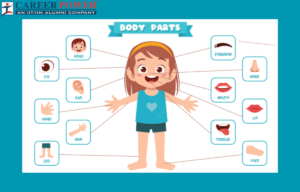Table of Contents
What is Glycolysis?
Glycolysis is a process in which glucose, a type of sugar, is broken down to release energy. It takes place in the cells of living organisms, including humans, animals, and plants. During glycolysis, one glucose molecule is broken down into two smaller molecules called pyruvate. This process occurs in the cell’s cytoplasm and does not require oxygen, making it an anaerobic process.

Through glycolysis, cells produce a small amount of energy in the form of ATP (adenosine triphosphate), which powers various cellular activities. Additionally, glycolysis produces molecules like NADH, which help in further energy production. Overall, glycolysis is an essential step in providing energy for cells to function.
Chemical Representation of Glycolysis
Glycolysis is the process by which glucose, a six-carbon sugar, is broken down into two molecules of pyruvate, each with three carbons, generating energy in the form of ATP and NADH. The overall chemical reaction for glycolysis is:
| Glucose + 2 NAD+ + 2 ADP + 2 Pi→ 2 pyruvates + 2 NADH + 2 H+ + 2 ATP |
This can be broken down into key stages:
- Energy Investment Phase
In the first phase, ATP is used to phosphorylate glucose and convert it to fructose-1,6-bisphosphate: Glucose (C₆H₁₂O₆) + 2 ATP → Fructose-1,6-bisphosphate
- Cleavage Phase
Fructose-1,6-bisphosphate is then split into two three-carbon molecules, each forming glyceraldehyde-3-phosphate (G3P).
- Energy Payoff Phase
In this phase, G3P undergoes several reactions to produce pyruvate, generating ATP and NADH in the process: G3P + NAD⁺ + 2 ADP + 2 Pᵢ → 2 Pyruvate + 2 NADH + 2 H⁺ + 2 ATP
Each molecule of glucose yields two pyruvate molecules, ready to enter the next phase of cellular respiration, either fermentation or the citric acid cycle, depending on oxygen availability.
Step Wise Process of Glycolysis
Glycolysis is the process by which glucose, a six-carbon sugar, is broken down into two three-carbon molecules called pyruvate. It takes place in the cytoplasm of cells and consists of ten steps, divided into two main phases: the energy investment phase and the energy payoff phase. Here’s a detailed step-by-step breakdown:

Phase 1: Energy Investment Phase
-
Phosphorylation of Glucose
- Enzyme: Hexokinase
- Process: Glucose is phosphorylated by ATP, turning it into glucose-6-phosphate. This step requires one ATP molecule, which provides energy for the reaction.
- Result: Glucose-6-phosphate
-
Isomerization
- Enzyme: Phosphoglucose isomerase
- Process: Glucose-6-phosphate is converted to fructose-6-phosphate, an isomer of glucose.
- Result: Fructose-6-phosphate
-
Second Phosphorylation
- Enzyme: Phosphofructokinase
- Process: ATP phosphorylates fructose-6-phosphate, producing fructose-1,6-bisphosphate. This step is highly regulated and irreversible, ensuring glycolysis continues.
- Result: Fructose-1,6-bisphosphate
-
Cleavage
- Enzyme: Aldolase
- Process: Fructose-1,6-bisphosphate is split into two three-carbon molecules: dihydroxyacetone phosphate (DHAP) and glyceraldehyde-3-phosphate (G3P).
- Result: DHAP and G3P
-
Isomerization of DHAP
- Enzyme: Triose phosphate isomerase
- Process: DHAP is converted into G3P so that both molecules can continue through the glycolysis pathway.
- Result: Two G3P molecules
Phase 2: Energy Payoff Phase
-
Oxidation and Phosphorylation
- Enzyme: Glyceraldehyde-3-phosphate dehydrogenase
- Process: Each G3P is oxidized, and a phosphate group is added, forming 1,3-bisphosphoglycerate (1,3-BPG). During this step, NAD+ is reduced to NADH.
- Result: 1,3-BPG and NADH (per G3P molecule)
-
ATP Generation
- Enzyme: Phosphoglycerate kinase
- Process: One phosphate group from 1,3-BPG is transferred to ADP, forming ATP. This is called substrate-level phosphorylation.
- Result: 3-phosphoglycerate and ATP
-
Isomerization
- Enzyme: Phosphoglycerate mutase
- Process: 3-phosphoglycerate is rearranged to form 2-phosphoglycerate.
- Result: 2-phosphoglycerate
-
Dehydration
- Enzyme: Enolase
- Process: 2-phosphoglycerate loses a water molecule, forming phosphoenolpyruvate (PEP), a high-energy molecule.
- Result: PEP
-
Second ATP Generation
- Enzyme: Pyruvate kinase
- Process: The phosphate group from PEP is transferred to ADP, producing ATP and pyruvate.
- Result: Pyruvate and ATP
Summary
-
Products per glucose molecule:
- 2 pyruvate molecules
- 2 ATP (net gain: 4 ATP produced – 2 ATP used = 2 ATP)
- 2 NADH molecules
Significance of Glycolysis
Glycolysis is a crucial metabolic pathway in cells that breaks down glucose, a six-carbon sugar, into two molecules of pyruvate, generating a small amount of energy in the form of ATP and NADH. this process is essential not only for generating cellular energy but also as a metabolic hub, supporting various biochemical processes in both oxygen-rich and oxygen-poor conditions. This process, which occurs in the cytoplasm, is significant for several reasons:
- Energy Production: Glycolysis provides quick energy, yielding 2 ATP molecules per glucose molecule, essential for cells that require immediate energy, like muscle cells during intense activity.
- Anaerobic and Aerobic Conditions: Glycolysis can proceed without oxygen (anaerobically), making it vital for organisms or cells in low-oxygen environments. It’s the first step in both aerobic and anaerobic respiration.
- Metabolic Intermediates: Glycolysis produces intermediates used in other metabolic pathways, like the synthesis of amino acids and lipids, and connects with the Krebs cycle in aerobic respiration.
- Universal Pathway: Glycolysis is highly conserved and occurs in nearly all organisms, from bacteria to humans, underscoring its fundamental role in energy metabolism across life forms.








 50 Vegetables Name for Kids in English a...
50 Vegetables Name for Kids in English a...
 Body Parts Name, All 50 Body Parts Name ...
Body Parts Name, All 50 Body Parts Name ...
 Flowers Names in English and Hindi, List...
Flowers Names in English and Hindi, List...









